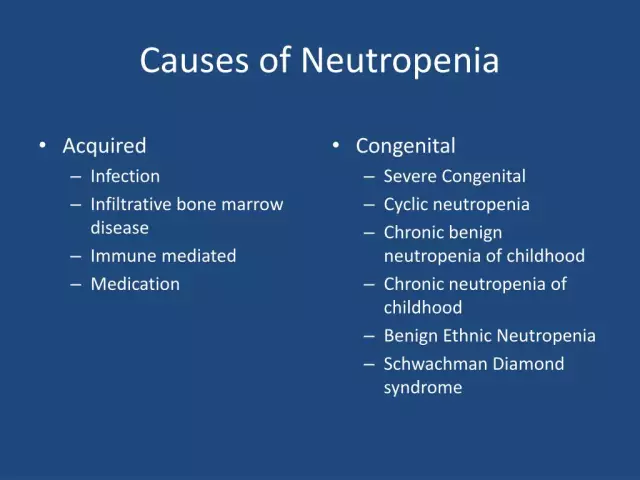- Author Rachel Wainwright [email protected].
- Public 2024-01-15 19:51.
- Last modified 2025-11-02 20:14.
Sliding hiatus hernia
The content of the article:
- How is a sliding hernia formed?
- Types of sliding hernias
- The reasons
- Symptoms of a sliding hiatal hernia
- Complications
- Diagnostics
- Sliding hiatal hernia treatment
- Video
A pathology in which the abdominal esophagus and part of the stomach penetrate the chest through the enlarged opening of the diaphragm and freely return to the abdominal cavity is called a sliding hiatal hernia. The disease is common, especially in women, and the likelihood of developing it increases with age. The course may be asymptomatic. The nature of complaints is determined by the type, degree of hernia and concomitant pathology of the gastrointestinal tract. For treatment, both conservative and surgical tactics are used.

A sliding hiatus hernia may be asymptomatic for a long time
How is a sliding hernia formed?
The diaphragm separating the chest and abdominal cavities has several physiological openings through which blood vessels, nerves and the esophagus pass. The tightness of the cavities in the area of the esophageal opening of the diaphragm (POD) is provided by a connective tissue membrane extending from the esophagus. Since the pressure in the abdominal cavity exceeds that in the chest, the presence of certain additional conditions makes it possible to stretch this thin obstruction and allows the lower esophagus and upper stomach to move into the chest cavity. This is how a hernia of the esophageal opening of the diaphragm (HH) is formed.
Types of sliding hernias
The most common type of hiatal hernia is a sliding (axial, axial) hernia, which is able to move freely, or slide, from the abdominal cavity to the chest cavity and back when the patient's body position changes. It has several classifications of its own, based on various characteristics.
| Basis of classification | Type, degree | Characteristic |
| Origin | Congenital | It is the result of congenital malformations of the ligamentous apparatus of the stomach, esophagus and diaphragm in the area of the AML, is rare, usually in early childhood. |
| Acquired | It occurs in the process of life, due to a sharp increase in intra-abdominal pressure, impaired contractility of the digestive tract, a decrease in tissue elasticity and muscle tone. | |
| Location of anatomical structures in relation to the POD | Ӏ degree | Only the abdominal, or abdominal, part of the esophagus enters the chest cavity, the lower esophageal (cardiac) sphincter is located in the POD, the stomach is adjacent to the diaphragm. |
| ӀӀ degree |
As a result of movement, the abdominal esophagus and the cardiac sphincter are in the chest cavity, the stomach is in the immediate vicinity of the POD. |
|
| ӀӀӀ degree | The abdominal esophagus, the cardiac sphincter, and part of the stomach through the POD are able to freely enter the chest cavity. | |
| The nature of the flow | Uncomplicated | No complications |
| Complicated | Complications develop: gastroesophageal reflux; inflammation, ulceration, cicatricial stenosis, esophageal perforation; bleeding, anemia, etc. | |
| Formation mechanism | Pulse | It is formed with a sharp increase in pressure in the abdominal cavity and weakness of the connective tissue structures, which fix the normal position of the organs in relation to the POD. |
| Traction |
Formation occurs with pathological longitudinal contraction of the esophagus and pulling of the cardiac sphincter to the POD as a result of irritation of the vagus nerves in a number of diseases: peptic ulcer disease, chronic inflammation of the gallbladder, etc. |
|
| Mixed | It arises when two mechanisms are realized: pulsation and traction. |
The reasons
Normally, the phrenoesophageal ligament fixes the lower part of the esophagus and protects the cardiac part of the stomach from exiting into the chest cavity during longitudinal contraction. Its retention in a certain position is additionally facilitated by the diaphragmatic fat layer and the natural arrangement of organs in the abdominal cavity. At the same time, the elasticity of the ligamentous apparatus allows not to disrupt the normal esophageal motility and with sharp contractions, for example, as with vomiting.
Sliding hernias can form when exposed to factors that disrupt the coordinated work of the listed structures.
| Unfavorable factor | Cause of occurrence |
| Increased intra-abdominal pressure | Severe obesity, chronic constipation, frequent crying and crying in infancy, indomitable vomiting, severe flatulence, ascites (accumulation of free fluid in the abdominal cavity), large abdominal tumors, abdominal trauma, pregnancy, severe and persistent cough, muscle tension in the anterior abdominal walls when lifting weights, hard physical work, sharp bends. |
| Weakness of the ligamentous apparatus | Age-related involutional processes that reduce the elasticity of connective tissue structures, leading to their degeneration and atrophy; emaciation, underweight; diseases accompanied by pathological changes in connective tissue: Marfan's syndrome, undifferentiated connective tissue dysplasia. |
| Impaired motility of the digestive tract | Peptic ulcer of the stomach and duodenum, chronic cholecystitis, pancreatitis, leading to dyskinesia of the esophagus - impaired motor function in the absence of organic lesions. |
| Longitudinal shortening of the esophagus | Reflux esophagitis (inflammation of the esophageal mucosa due to the return of gastric contents into it), peptic ulcer, thermal or chemical burn, causing shortening of the esophagus due to its scarring and deformation. |
Symptoms of a sliding hiatal hernia
Very often, sliding HHNs exist completely without symptoms and are discovered by chance in patients with a wide variety of diseases. But if complaints appear, then the following are typical:
- heartburn observed after eating and worsening in a horizontal position;
- pain in the epigastrium, extending upward, sometimes radiating to the interscapular region and back, arising after eating and aggravating in the supine position, tilting the body forward;
- belching with air or stomach contents;
- regurgitation (regurgitation), not accompanied by nausea, occurring after eating, in a horizontal position, during exercise;
- Difficulty swallowing, more often when taking liquid or semi-liquid food;
- hiccups, characterized by a long duration and connection with food.
The clinical picture is largely determined by the size of the hernia, the state of the mucous membranes of the digestive tract, and the presence of complications.
Complications
The intensity of the complaints increases if complications develop. The most typical ones are:
- reflux esophagitis;
- inflammation and ulcer of the hernial part of the stomach;
- bleeding esophageal or gastric;
- narrowing of the lumen or shortening of the esophagus;
- intussusception of the esophagus - the introduction of its lower part into the hernial sac;
- perforation of the esophagus.
Bleeding with HH is often accompanied by anemia - a decrease in the concentration of erythrocytes and hemoglobin in the blood.
Diagnostics
For the diagnosis of pathology, a thorough interview of the patient is important. Additional examination includes conducting:
- esophagogastroscopy;
- X-ray of the chest, esophagus, stomach;
- esophagomanometry (measurement of pressure in the esophageal cavity);
- impedance-pH-metry (determination of the acidity of the esophagus and electrical resistance of its contents).

Esophagogastroscopy allows you to reliably establish the diagnosis
Sliding hiatal hernia treatment
Axial hiatal hernia therapy begins with conservative measures aimed at:
- prevention and treatment of gastrointestinal reflux;
- normalization of acidity;
- elimination of inflammatory changes in the mucous membranes;
- correction of violations of the motility of the digestive tract;
- treatment of concomitant diseases and complications.
The list of medications includes:
- proton pump inhibitors (Omeprazole, Lansoprozole, Pantoprazole, Rabeprazole);
- blockers of H2-histamine receptors (Ranitidine, Cimetidine, Famotidine, Roxatidine);
- prokinetics that stimulate motor skills (Raglan, Cerucal, Bimaral, Ganaton);
- antacids that neutralize hydrochloric acid (Gastal, Almagel, Fosfalugel, Gastracid, Rennie, etc.) and alginates (Gaviscon, Laminal).
Both for prevention and for the effectiveness of therapy, it is of no small importance:
- diet;
- normalization of weight;
- to give up smoking;
- limiting alcohol;
- exclusion of overeating;
- not allowing food at night;
- a ban on foods, drinks that stimulate acid production in the stomach;
- being in an upright position after eating;
- elimination of conditions that cause an increase in pressure in the abdominal cavity;
- sleeping in a bed with a raised headboard.
Complicated forms of hiatal hernia, the failure of drug therapy or the presence of pronounced dysplastic changes in the mucous membrane of the esophagus are forced to resort to surgery.
Video
We offer for viewing a video on the topic of the article.

Anna Kozlova Medical journalist About the author
Education: Rostov State Medical University, specialty "General Medicine".
Found a mistake in the text? Select it and press Ctrl + Enter.






